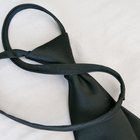
Nothing sets off a man's style like a tie -- but only if the tie knot is crisp and well-presented. Many styles exist for tie knots, each suited to a particular tie or function. The Windsor knot, for instance, is the classic formal tie knot but works best with thinner, narrower ties. For a slightly less formal knot that works with most any tie, use the half-Windsor instead. Then there's the four-in-hand knot, which is a good semi-casual knot for any tie. Regardless of the knot or tie involved, however, you need to tighten it properly or your best efforts will still result in a slightly sloppy appearance.
Tie your necktie according to the knot you desire. There are 85 different tie knot styles -- although only about ten are commonly used today. (Ref 1) Create the knot about halfway up your tie, or breast level, so that when the knot is complete, you must slide it up the remaining half to your neck. Leave the knot loose enough to insert a finger in from the bottom.
Grasp the skinny end of the tie with your left hand and hold in place at stomach level. (Ref 2) Your left hand should not move while you tighten the tie -- your right hand will do all the work.
Cup your right hand over the tie knot so your hand completely encloses the knot. Push your index finger up inside the center of the knot slightly, so your thumb is on one side of the knot, your last three fingers on the other side, and your finger barely inside the pocket your tie knot forms. You can skip putting your finger in it, but it will give your tie that extra bit of style if you do. (Ref 3)

Squeeze the sides of the knot together and slide up with your right hand. Retain the fingertip inside the knot as the tie slides up towards your neck. Stop when you reach your neck, leaving it slightly loose for final adjustments. (Ref 3)
Manipulate your necktie knot, tightening and fluffing the knot (Ref 4) and adjusting the skinny and wide ends where they leave the knot. Make the dimple created in the bottom of the knot (the drape of the tie leaving the knot) as distinct as possible. Dimples create visual depth and form in Windsor and half-Windsor knots most readily; some knot styles may have irregular and poor-looking dimples. (Ref 3)
Tighten the necktie if needed, making sure the tie is snug but not too tight around your throat. Turn your shirt collar down to complete.
Related Articles

How to Tie a Necktie Shorter

How to Loosen a Tie

How to Tie a Man's Tie in the European ...

How to Tie a Square Knot Necktie

How to Use a Square Knot for Dress or ...

How to Retie a Pre-Tied Tie

How to Keep Your Neck Tie From Slipping

How to Tie a Zipper Tie

One-Handed Method for Ponytails

How to Tie a Military Tie

How to Tie a Necktie for Dummies

How to Put On a Clip-on Tie

How to Tie a Tube Scarf

How to Tie a Necktie Step-by-Step

How to Tie a Sailor's Necktie

How to Tie Swimsuit String for Men

How to Tie a Jabot Knot

How to Tie a Male Sarong

How to Make a Rose Scarf

How to Wear a Scarf in Five Different ...
References
Writer Bio
Karie Fay earned a Bachelor of Science in psychology with a minor in law from the University of Arkansas at Monticello. After growing up in construction and with more than 30 years in the field, she believes a girl can swing a hammer with the best of them. She enjoys "green" or innovative solutions and unusual construction.
Photo Credits
Goodshoot/Goodshoot/Getty Images